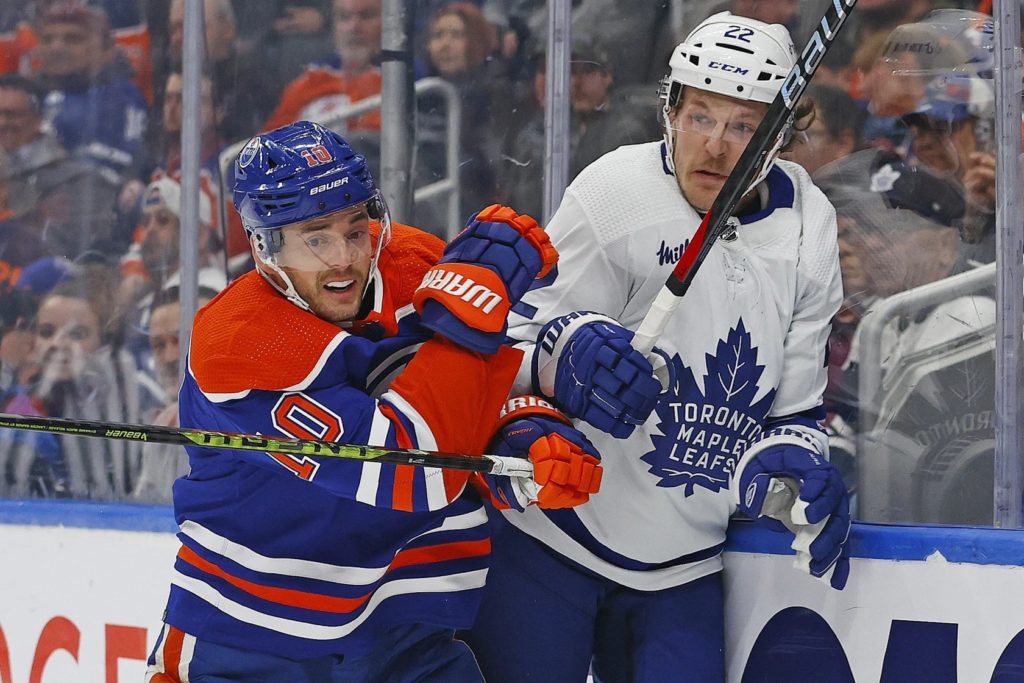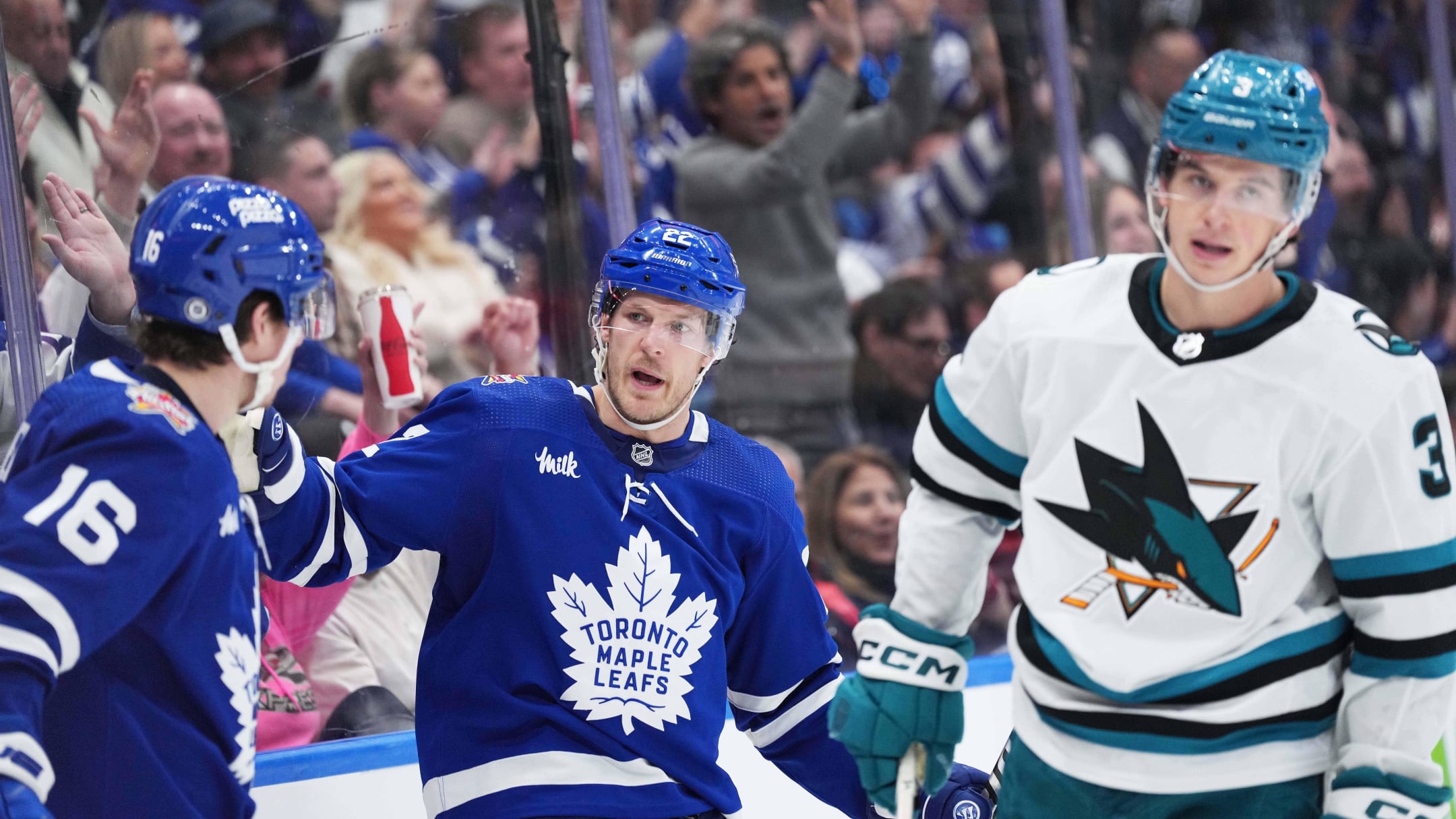In the final edition of my evaluations of under-contract Maple Leafs, we’re breaking down the seasons of Jake McCabe and Simon Benoit, two defensemen who took big strides forward as individuals and as a pairing in 2023-24. What do their roles look like moving forward on a Toronto defense group in line for some offseason reshaping?
You can catch up on the other six pieces in the Offseason Evaluations series below:
- Offseason Evaluations, Part 1: Auston Matthews & William Nylander
- Offseason Evaluations, Part 2: Mitch Marner & John Tavares
- Offseason Evaluations, Part 3: David Kampf & Calle Jarnkrok
- Offseason Evaluations, Part 4: Bobby McMann & Matthew Knies
- Offseason Evaluations, Part 5: Pontus Holmberg & Ryan Reaves
- Offseason Evaluations, Part 6: Morgan Rielly & Conor Timmins
Jake McCabe

| Jake McCabe | |
|---|---|
| 2023-24 Production | 8 goals and 28 points in 73 games (20:39 per game) |
| 5v5 Results | 51.19 CF% | 52.43 xGF% | 63 goals for, 51 goals against |
| Contract Status | One year remaining at a $2 million cap hit for the Leafs ($4 million AAV overall) |
Jake McCabe enjoyed a career year in his first full season with the Leafs, potting eight goals (his previous career high was four) and 28 points (his previous career high was 22). His 20:39 per game was just three seconds below his career high time in ice time per game (20:42). This also marked the first season when McCabe played on a playoff team from the beginning to the end of the schedule, which is noteworthy, knowing that playing on losing teams can ingrain bad habits. McCabe’s habits improved as the season went along, and he took on more and more responsibility as a result.
The start of the 2023-24 season was actually quite rocky for McCabe, who initially partnered with John Klingberg. At the time, it was viewed as a stylistic fit between an offensive defenseman and a defensive defenseman, but I think this idea was rooted in a misunderstanding of McCabe’s game. He likes to rove offensively and get involved in the play; he isn’t a “hang back” type of player. McCabe-Klingberg were buried in every category and outscored 5-1 in nearly 42 five-on-five minutes together.
McCabe went pointless in seven games in October and then picked up two assists in November, giving him just two points in 15 games to start his campaign. When Klingberg’s season ended due to injury and the pairing was permanently split up, McCabe spent quite a bit of time with Mark Giordano. They played over 103 minutes together at five-on-five and won their minutes across the board (shot attempts, scoring chances, and actual goals – 8-5). Playing with Giordano was really the first time we saw McCabe move over to the right side, which appeared to settle his game down. He didn’t take as many chances – a hallmark of his game on the left side after the Leafs acquired him, leading to several costly, high-risk pinches. On the right side next to Giordano, McCabe played within himself.
It wasn’t until December that McCabe received his first look alongside Simon Benoit in a 4-0 win against Nashville, arguably the team’s best overall game to that point in the season. However, the pairing didn’t immediately stick as McCabe rotated through several partners throughout December, including William Lagesson. Funny enough, December was McCabe’s most productive month of the season, with eight points in 13 games. He followed it up with seven points in 13 games in January, which is when he started to pair up with Benoit regularly.
In terms of deployment, the Benoit-McCabe pairing was buried defensively compared to McCabe’s pairing with Giordano. McCabe’s offensive-zone faceoff percentage alongside Benoit was 31.45 percent compared to 44.26 percent with Giordano. His offense did take a dip accordingly; he played almost entirely with Benoit down the stretch after the All-Star break, tallying only 11 points in 32 games. After the trade deadline, the coaching staff also briefly tried reuniting McCabe with TJ Brodie as a shutdown pairing, but it was very clear the pairing was not a viable option (Brodie’s game was too far gone).
In the playoffs, McCabe notched a single point — a critical goal in Game 5 — and his ice time went up nearly a minute per game. Playing primarily with Benoit, McCabe’s pairing started just 30 percent of their faceoffs in the offensive zone (and his one goal came off a faceoff play in the O-zone). Even still, they won their five-on-five minutes in terms of shot attempts and scoring chances and drew even in actual goals at 4-4.
Used in a heavy shutdown role, McCabe played more against David Pastrnak than any other Bruins forward. Pastrnak scored the series winner, but McCabe wasn’t on the ice for it. Before his series winner, Pastrnak was called out by his head coach for not producing (McCabe vs. Pastrnak finished at 2-2 in goals in the series). Simply put, McCabe did his job. If you were told the Leafs‘ primary shutdown pairing would draw the Pastrnak matchup, you would expect the rest of the team to win out on their matchups and thus win the series.
McCabe’s game took big strides forward this season. He showed that he can viably lead a shutdown pairing, play the left or right side, and chip in solid production. He’s a good all-around player, a top-four defenseman, and one of the better hitters in the league. He comes to the arena in a bad mood (meant as a compliment). To me, a number-three defenseman can drive a second pairing to good results, and that’s what McCabe accomplished this season.
Like most of the team, one area McCabe can work on moving forward is the penalty kill. He was part of a mediocre unit this season and was often tasked with playing the right side while shorthanded – a much more difficult assignment on the PK, where he struggled on his weak side of the ice. In the previous season, he played the left side on the penalty kill and was much better. Would simply acquiring proper right-handed penalty-killing defensemen do the trick?
It took McCabe some time to adjust when the games tightened up in the playoffs, but he was solid for the Leafs as the series wore on. The game would be easier from a transition standpoint if he were playing his natural side, so it will be interesting to monitor if the Leafs plan to start next season with the Benoit-McCabe pairing still in place or if they look to pair McCabe with a right-handed partner who has more of a track record of handling top-four minutes.
Truthfully, one can make a case either way, but even if management does plan to start the season with Benoit-McCabe still together, the Leafs should really look to add two top-four defensemen—one to play with Rielly and one to either pair with McCabe or drive a separate pairing altogether.
The nice part of McCabe’s ability to play either side is that the team will have options either way. The main point is that the Leafs need to add more quality to their defense group if they are serious about contending in 2024-25.
Simon Benoit

| Simon Benoit | |
|---|---|
| 2023-24 Production | 1 goal and 5 points in 64 games (17:14 per game) |
| 5v5 Results | 50.93 CF% | 52.15 xGF% | 44 goals for, 36 goals against |
| Contract Status | Three years remaining at $1.35 million AAV |
At the end of August, the Leafs signed Simon Benoit to a one-year contract that became one of Brad Treliving’s most shrewd pieces of business all year. It didn’t start off with such a bang, though.
Benoit came to training camp looking to make the NHL roster but got injured, struggled when he did play, and was placed on the waiver wire, where he went unclaimed. He started the season with the Marlies but was quickly called up on loan after Conor Timmins fell injured. He didn’t play a game in either the NHL or AHL until October 27, but on November 6, Benoit debuted with the Leafs and never really looked back.
In November, Benoit played eight games and logged just 13:50 per night. He was paired primarily with William Lagesson on a no-frills pairing that held serve in limited minutes; they generally won their shifts territorially and were only on the ice for three goals total in 104 minutes together (outscored 1-2). It wasn’t much, but receiving some simple, relatively safe minutes was a welcome addition for a Leafs team that was a complete mess defensively at the time.
As noted above, in December, Benoit started pairing some with McCabe and saw his ice time go up. He averaged 15:37 per game in 12 December games and was also credited with 43 hits as he started throwing his body around with more regularity once he settled into the team. By January, his ice time again increased (averaging 17:03 per game), and after going pointless through his first 23 games of the season, he notched his first point of the season in early January against the Sharks.
February was Benoit’s best month of the season. As we’ve stated several times throughout these writeups, this was the month when the Leafs cemented their playoff spot. With Rielly suspended, Benoit averaged 19:53 per night, easily his most ice time in any month. He even added two assists in 13 games to go along with 53 hits and 19 blocked shots.
Coming out of the All-Star break, Benoit ran Mat Barzal and dropped the gloves with Bo Horvat. In a mid-February game against the Flyers, he steamrolled Cam York and fought Nicolas Deslauriers afterward. He was asserting himself physically and impacting games with his aggression. Not every player can change a game with a goal, but Benoit has the ability to impact the game in other ways with his physicality.
In March, the Leafs added some veteran defensemen, and Benoit’s game also showed a few cracks, including a few giveaways that either led directly to goals against or required a big save to bail him out. After the deadline, Benoit found himself a healthy scratch, but similar to the start of the season, he took everything in stride. When he got an opportunity to return to the lineup, he didn’t give the coaching staff a choice to take him out again. It’s easily the most likable attribute of Benoit’s: when things don’t go his way, he doesn’t sulk; he works harder.
By the time playoffs rolled around, he was locked into the lineup alongside Jake McCabe in a shutdown role and acquitted himself well. He got better as the games tightened up, playing over 17 minutes in each of the Leafs’ Game 5 and Game 6 victories, followed by a series-high 20:28 in Game 7.
While his physicality is often noted, one aspect of Benoit’s game that doesn’t receive enough attention is his skating. Benoit is a little awkward with the puck – which can impact how he is perceived – but as a pure skater, he owns a great stride. That’s why he’s hardly ever burnt defensively. He moves around very well for a 6’4 defender, and when we couple his length with his skating and physicality, it makes for a good package.
On the flip side, Benoit clearly needs to work on his play with the puck. He’ll likely never be a big-time point producer, but he can’t be much more than a third-pairing defender if he’s producing only five points in a season (he did record 10 the year before in Anaheim, including three goals). Against Boston, I thought he was pushing himself to get more involved offensively, even ripping a one-timer off the post at one point.
Benoit will fare well in a defensive, shutdown role, but it’s important that he can make plays and facilitate the puck moving the other way. If we use Chris Tanev as an example of what the high end of an elite shutdown defenseman who doesn’t produce much offensively can look like, Tanev still produces roughly 20 points (or plays at that points pace) each season.
Beyond an uptick in puck-moving ability and offensive production, the other key for Benoit to play more on a nightly basis will be an improvement on the penalty kill. He averaged just 1:36 on the PK in the regular season and 1:12 per game there in the playoffs. He was either their fourth or fifth option among defensemen. Even if the offensive part of his game never develops to the point where he can be a viable top-four defenseman night in and night out, he needs to be a reliable penalty killer to justify his spot in the lineup as a physical defensive defenseman who doesn’t produce much offense. He has the length to block passes and the courage to block shots. He likely only needs repetition and refinement.
I certainly wouldn’t bet against Benoit continuing to work and improve in the above-mentioned areas. He was rightfully rewarded with a three-year contract, and I’d argue that he’s already worth at least double his current annual average. He takes good shifts and adds an element every team in the league is always seeking. If he can solidify himself as a penalty killer and add just a tad more offense to his game, the Leafs will have a real find on their hands, one they’re paying pennies on the dollar against the cap.


![Craig Berube on Easton Cowan rejoining the Leafs: “He’s given us some really good games… The [demotion] was just a move made for roster reasons, but he’s back” Craig Berube, Toronto Maple Leafs head coach](https://mapleleafshotstove.com/wp-content/uploads/2025/04/berube-craig-leafs-prac-218x150.jpg)











![John Gruden after the Leafs prospects’ 4-1 win over Montreal: “[Vyacheslav Peksa] looked really comfortable in the net… We wouldn’t have won without him” John Gruden, head coach of the Toronto Marlies](https://mapleleafshotstove.com/wp-content/uploads/2025/09/gruden-post-game-sep-14-218x150.jpg)











![Craig Berube on Easton Cowan rejoining the Leafs: “He’s given us some really good games… The [demotion] was just a move made for roster reasons, but he’s back” Craig Berube, Toronto Maple Leafs head coach](https://mapleleafshotstove.com/wp-content/uploads/2025/04/berube-craig-leafs-prac-100x70.jpg)






